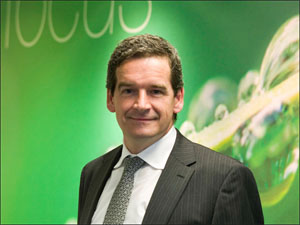Why CBA's Harte is worth $4.2m

commentary I almost spilled my coffee all over my desk last week when I read the Commonwealth Bank's annual report and discovered that its chief information officer Michael Harte had picked up no less than $4.2 million in remuneration over the 2010 financial year — a $1.4 million pay rise.

Michael Harte (Credit: Commonwealth Bank of Australia)
I mean, sure, the dapper Harte looks good in a suit and generates constant good PR for the bank by threatening to keelhaul vendors and make them walk the plank if they don't sign on to his cloud computing vision. And there is that little matter of the $730 million core banking IT overhaul he's been steering for the past two years, without many glitches that we know of. But he's just one man.
The pay packet increase is particularly startling if you realise that it constitutes a rise of about $1.4 million, and if you look back at 2009, you'll see that Harte picked up an amazing sum of $2.7 million. The difference in 2010 was mainly due to long-term incentive payments.
To most workers in Australia's IT industry, Harte's astronomical salary must seem remarkable. After all, entry-level graduate IT salaries typically start around the $50k to $60k mark, and only gradually go up into the hundreds of thousands after you become a senior manager. The situation in the public sector is even worse, it's not uncommon for a departmental CIO to earn less than $200k.
Of course, you can earn a lot more working for one of the big technology vendors, but Harte doesn't; he's an IT buyer, not an IT seller.
But the truth is that increasingly Australia's private sector will be seeing more examples of highly paid chief information officers like Harte and there's a good reason why.
When Harte joined the Commonwealth Bank in 2006, his title was chief information officer, in charge of the bank's technology support division. Since that time the high-flying executive's role has changed substantially.
In October 2008, the bank went through a substantial reorganisation that saw a new division created — Enterprise Services — which Harte was appointed to lead, while maintaining his existing CIO title. Quoting from Harte's CBA biography:
The Group formed Enterprise Services in October 2008 to enable an end-to-end service and process focus as well as accelerate the delivery of innovative customer solutions.
What this really means, when it boils down to it, is that Harte is no longer really just a chief information officer or technology executive. Or, looking at it the other way around, that the CIO role in large Australian organisations is increasingly changing away from just being focused on IT.
You can see a similar trend in other large local organisations.
At ANZ Bank, for example, although it appointed a new CIO (Anne Weatherston) this year, it's clear that ultimate responsibility for the bank's IT systems rests with the company's chief operating officer David Cartwright, including, for example, the bank's offshore facility in Bangalore, India. Any major technology project is likely to involve Cartwright's sign-off.
It was Cartwright, after all, in his previous role as group managing director of operations, technology and shared services (along with a little help from deputy CIO Kieran Griffiths) that oversaw ANZ's IT strategy in the year it took the bank to replace previous CIO Peter Dalton.
NAB chief information officer Adam Bennett likewise has a higher master, Gavin Slater, the bank's chief executive of Group Business Services, who also lists technology among his responsibilities.
Bob McKinnon is lucky enough to run his own shop as Westpac group executive of Technology. But Qantas' IT function has been for the past several years been led by group executive of Corporate Services and Technology David Hall, with other executives such as head of technology Segar Reddy taking a low profile.
Hall publicly described himself in August 2009 as a "quasi-chief information officer", and I think this title is an apt one to describe what the top level of IT executives at major Australian organisations often do these days.
Harte, McKinnon and co are paid millions of dollars each year not because they run IT infrastructure and make technology strategy decisions. The truth is that the modern CIO role is evolving to become more akin to the head of operations in many organisations, with broad responsibility for ensuring that all aspects of a company's systems meet operational outcomes.
This reflects the fact that the entire day-to-day business of many corporations consists of technology-related transactions. In 2010, banks are essentially just huge batches of datacentre racks with a few branch offices and call centre staff for support. Their main business doesn't rely on technology — it is technology.
In this sort of environment, two types of top-level executives will win out. The first will be those, like Harte, who take the step up from their IT roles and increasingly handle operational responsibility for their organisations. This is why Harte is being paid so much; he's no longer just an IT chief.
The second will be those, like Qantas' Hall, who subsume IT into their operational mandate. This sort of executive represents a danger to the traditional CIO, because they have the potential to take away much of the responsibility and power of the role, as Hall did at Qantas.
Canny senior IT managers in 2010 will see this shift coming and prepare for it. It's time to diversify and prepare to take the step up that Harte did at the Commonwealth Bank. The alternative is to be eventually relegated to obscurity due to your lack of foresight and diversified skills.